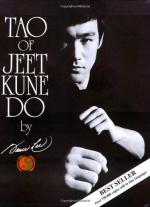
|
| Name: _________________________ | Period: ___________________ |
This test consists of 5 multiple choice questions, 5 short answer questions, and 10 short essay questions.
Multiple Choice Questions
1. What may be used to anticipate and intercept the final line of attack if an opponent is making an attack?
(a) Psychic energy.
(b) A stop-hit.
(c) Reaction time.
(d) A block.
2. Why is Bruce Lee confined to his bed?
(a) He has recently lost his sight.
(b) He is recovering from a coma.
(c) He breaks his legs.
(d) He suffers from a back injury.
3. Lee believes that when one understands the _____, the _____ are understood as well.
(a) Sky/Clouds.
(b) Grass/Seeds.
(c) Root/Blossoms.
(d) Moon/Waves.
4. Lee teaches that the ripening of an individual with his being is not possible without ______.
(a) Understanding the history of martial arts.
(b) Self-exploration in free expression.
(c) Six weeks of training.
(d) Letting go of a need to win.
5. Lee states that _____ is filled with life, power, and love of all beings.
(a) The Tao of Jeet Kune Do.
(b) Martial arts.
(c) Activism.
(d) Realization of the void.
Short Answer Questions
1. According to Lee, what is achieved by practice to form neural pathways?
2. Lee says the hook should start and end in the position, without _____.
3. What response must the opponent be in, according to Lee, in order for the fighter to break the rhythm to catch the opponent off-balance?
4. What state of mind should a student have while training?
5. What does Lee recommend to counter an attacking opponent?
Short Essay Questions
1. Why do different types of activities require different warm ups?
2. What benefit does Lee say a fighter has in taking a low-line position?
3. What does Lee mean when he says, "The strike should be felt before it is seen?"
4. Why is a winning attitude important in Jeet Kune Do?
5. When is reaction time longer?
6. Why does Lee mention tools of judo and ju-jitsu in Chapter 4?
7. Why does Lee say body feel important to develop in kicking?
8. Why do Lee and the editor devote so much detail to the on-guard position and proper posture?
9. Why does Lee call Western boxing over-daring?
10. What is the benefit of determining cadence?
|
This section contains 697 words (approx. 3 pages at 300 words per page) |

|




